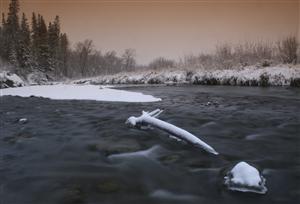Human Influence on the Water Balance
Human activity has the potential to indirectly and directly affect water quantity and the natural flow regime of a river system. Indirect impacts to the hydrologic cycle can result from land-use changes. Direct impacts can result from water diversions, withdrawals and discharges, and from dams (flow regulation and water storage).
Land Use Changes
Changes to the landscape caused by oil sands development can affect hydrologic systems in two major ways, termed closed circuited and non-closed circuited land use. Closed circuited areas include areas where the impacted land is hydrologicaly isolated from the original drainage area, and no longer contributes flow to the river system. Non-closed circuited land change includes areas that still contribute flows to the river systems, but where vegetation has been removed or other changes affecting water flow have occurred.
Withdrawals, diversions and discharges
Water use is managed in the Athabasca oil sands area by the Alberta government, under the provincial Water Act. The purpose of the Water Act is to manage and regulate the allocation and use of water, and to support and promote water conservation.
Oil sands projects are a significant user of water from the lower Athabasca River. While the use of water by industrial oil sands projects has historically been considered low enough to maintain aquatic health for the mainstem of the Athabasca River, current licenses allow for maximum amounts that are potentially of concern during low flow conditions. To protect the aquatic health of the Athabasca River under low flow conditions, an Instream Flow Needs and Water Management System was developed for the lower Athabasca River (AENV and FOC 2007). This framework identifies management actions, including water use restrictions, related to river flow conditions. The objectives of the water management framework are to:
- Provide a high level of protection for the aquatic ecosystem over the long-term;
- Provide incentive to develop cooperative management options for water in the Athabasca River;
- Provide incentive for achieving more efficient water use;
- Provide a reliable supply of good quality water; and
- Ensure water use restrictions are realistic and the framework is straightforward to administer.
Dams
While there are no flow-regulating dams on the Athabasca River, the W.A.C. Bennett Dam regulates flows on the Peace River. The effects of flow regulation on the natural hydrologic balance of the Peace-Athabasca Delta have been of concern for decades. The ecology and health of the Delta, supporting a diverse population of flora and fauna, are dependent on the flow interaction of the Peace and Athabasca River systems (Environment Canada 2002). Flows in the Athabasca River are an important component of the overall health of this internationally important and delicately balanced ecosystem.
Within the Athabasca River watershed, and specifically within the oil sands area, dams are used to create tailings ponds to store industrial wastewater produced in some oil sands developments. These tailings ponds represent an increased risk to downstream aquatic systems through the presence of large volumes of contaminated water stored within some regional watersheds. “Water stored in tailings may represent the most pressing environmental liability of the region and this can be addressed by enhancing the efficiency of water use, and finding ways to either recycle or treat and discharge these waters” (AENV and FOC 2007).
Climate Change
Several predictions have been made regarding the potential impact of climate change on the hydrology of the Athabasca River system. The model WATFLOOD reveals that in the event of climate change, elevated winter flows and an earlier melt season may occur throughout the Peace-Athabasca Delta, and the Athabasca River will have overall higher flows in its lower reaches (Toth et al. 2006). Although most models agree about the earlier melt season, the flow level is sensitive to temperature and precipitation parameters entered into the model. Some parameters indicate that lake and river levels will be lower as a result of increased evaporation rates (Pietroniro et al. 2006). Kerkhoven and Gan (2008) predict that there could be significantly reduced flows in the Athabasca River system by the end of the century (2070-2099). These reduced flows would be primarily related to the predicted decrease in winter snowpack due to warmer winter temperatures.









